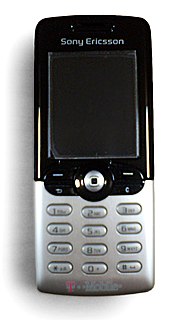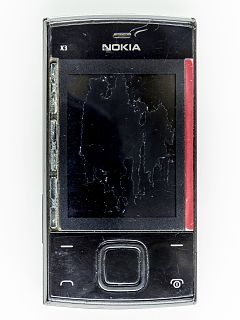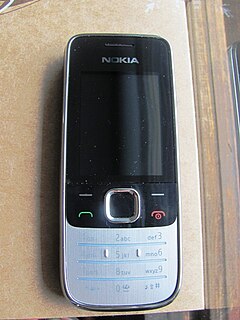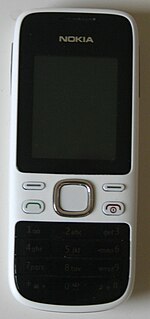The Siemens CX75 was released in 2005, and is a mobile phone manufactured by the German/Taiwanese company BenQ Mobile.
The CX75 is a triband cameraphone that can take digital photographs up to 1280x1024 pixels in size. It includes 2.5G technologies, supporting GPRS class 10 connections with WAP 2.0 capability. It supports polyphonic ringtones in MIDI as well as tones in the MP3, AAC(+) and WAV formats. On the mobile gaming side, the phone supports Java ME MIDP 2.0. It has 8.29 MB of onboard memory available for the user, and supports RS-MMC cards for further expansion. The phone is similar to the specifications of the Siemens M75, apart from the protection system of the M75, in addition to weight, size and keys.
In early FW versions (FW2, 5), the phone suffered from some bugs and in general bad performance, especially in menus. This has been mostly corrected in the latest FWs. It is suggested to upgrade to FW13, and not the latest FW23, as it does not improve the phone a lot, and some users have experiences problems with this. The FW is user-serviceable, by using a DCA-510 or a DCA-500 datacable, it is possible to upgrade to the newest FW, which is found on the official BenQ-Siemens site.
The Motorola MPx200 Smartphone was launched in December 2003 as a joint venture between Motorola and Microsoft. The mobile phone's Windows Mobile for Smartphone OS allows users to access email and the Internet, use MSN Messenger, and view documents in Microsoft Office formats much like other Windows smartphones such as the Samsung SGH-i600 or HTC Tanager. The MPx200, along with the Samsung SCH-i600, were the first Windows Mobile smartphone devices to have wide distribution in the United States. Previously, smartphone platform devices could only be purchased in the United States as part of development kits sold by Microsoft. The only U.S. carrier of the phone was AT&T Wireless; however, reports also suggest a somewhat limited number of devices with Cingular branding have appeared following the purchase of AT&T Wireless by Cingular.

The Sony Ericsson T610, released in 2003, is a mobile phone manufactured by Sony Ericsson. It was one of the first widely available mobile phones to include a built-in digital camera, Bluetooth, color screen, joystick navigation, and was a very high selling model. The T630 was a later variant.

Siemens Mobile was a German mobile phone manufacturer and a division of Siemens AG. Siemens sold Siemens Mobile to the Taiwan-based BenQ in 2005, subsequently becoming BenQ-Siemens and succeeded by Gigaset. The last Siemens-branded mobile phones, the AL21, A31 and AF51, were released in November 2005.
Siemens SL45 was the first mobile phone with memory expansion and an MP3 player, which debuted in 2001. An improved version, the SL45i, was also the first phone to have a Java virtual machine.
The O2 Xda brand was a range of Windows Mobile PDA phones, marketed by O2, developed by O2 Asia and manufactured by multiple OEMs (mainly HTC, Quanta and Arima). The first model was released in June 2002. The last models came to market in 2008. The "X" represents convergence of voice and information/data within one product; the "DA" stands for "Digital Assistant", as in PDA. The name of XDA Developers is derived from it.
Sony Ericsson Z800i is a 3G mobile phone developed by Sony Ericsson and released in 2005. The Z800i is a phone that is identical to the Vodafone branded Sony Ericsson V800. The difference between these two phones is that the Z800i can be found not branded to any mobile phone service provider, and it has different colour variations.

The Siemens M75, this is the successor of Siemens M65. The phone released in 2005, is manufactured by the German/Taiwanese company {Siemens Mobile}- BenQ Mobile. It is one of the few mobile phones to be weather and shock resistant, while not skimping on other features like a 1.3MP digital camera, 262k color screen and a digital music player supporting the MP3 and AAC formats. It comes in 2 color variants, safari green and black.

The Nokia 7710 is a smartphone developed by Nokia and announced on 2 November 2004. It was the first Nokia device with a touchscreen, and first Nokia branded device with 2:1 aspect ratio display. The 7710 is based on the Nokia 7700 which was never released. It is Nokia's only smartphone to run the Series 90 interface atop Symbian OS v7.0s.

The Sony Ericsson W610i phone is based on the Sony Ericsson K550 and Sony Ericsson K610i. It is a quad-band GSM phone, but it does not offer 3G. The W610i has colour options similar to the Sony Ericsson W880i. This phone uses the TrackID and version 2.0 of the Walkman player.
The Nokia 6000 series or Classic Business series is range of mobile phones marketed by Nokia. This family of phones is notable for their conservative, unisex designs, making the family popular with business users.

The Siemens C75 is a mobile phone sold by Siemens. The C75 is a triband cameraphone. It weighs 85 g and dimensions are 103 x 44 x 17 mm. It includes GPRS class 10 connections with WAP 2.0 capability and IrDA. It supports polyphonic ringtones in MIDI and WAV formats. It has 10,2 MB of onboard memory available for the user. The phone also includes digital imaging and picture messaging. It has a built-in camera capable of taking pictures in VGA resolution and recording videos. It also supports SMS archiving.

The Motorola Q9c is a Windows Mobile 6 Smartphone, a thin device with similar styling to Motorola's immensely popular MOTORAZR.

The Siemens AX72 is a mobile phone introduced by Siemens in October, 2005. It weighs 79 g and its dimensions are 105,6 x 46,8 x 17,5 mm. Its display a CSTN 65K colors LCD.

Nokia X3-00, is a multimedia-oriented mobile phone produced by Nokia. It comes with stereo-wide speakers, built-in FM radio with RDS, a standard 3.5 mm audio jack, media player and 3.2 megapixel camera. The phone runs under the Series 40 software platform. It was announced on September 2009 and later released in December 2009 worldwide.

The LG KF900, also known as the LG Prada II, is a touchscreen, with slide out qwerty keyboard, mobile phone made by LG Electronics. It is the second version of the Prada phone, following the original LG Prada (KE850). The phone's looks are basically the same as the original Prada, but the Prada II is slightly thicker, taller and heavier, to support a slide-out full QWERTY keyboard. There is also a front-facing camera for use with video calling. The interface has been updated from the original. The camera has been increased from 2 to 5 megapixels with a LED photolight. The Prada II also now supports 3G and HSDPA for faster internet browsing. The Prada II has support for the Prada Link, which is bluetooth watch that allows information on incoming phone calls or text messages, the phone's alarm, or the world time clock.

The Nokia 2730 classic is a Nokia Quad-band GSM/UMTS 3G cell phone that includes a camera, FM radio, Bluetooth, music and video player, as well as several internet-based applications.
The Nokia 2700 classic is a Nokia quad-band GSM cell phone. It has a camera, FM radio, bluetooth connectivity, multimedia playback, and several internet-based applications. It is assembled in Romania.

The Nokia 2690 is a mobile phone released by Nokia in March 2010. It operates on GSM quad band frequency 850, 900, 1800 and 1900 MHz, with automatic switching between frequencies. It has dimensions of 107.5 × 45.5 × 13.8 mm and weighs 80.7 grams.

The Nokia X2-01 is a low-cost feature phone with a Nokia S40 mobile operating system released under the X-series line of phones by Nokia. It features a full QWERTY keyboard. It is being advertised as an entry-level messaging & Music phone. It's similar to the Nokia X2-00, only differences are that it has a QWERTY keyboard, the display is landscape and has a downgraded VGA camera with no flash.

The Samsung S400i is a slider mobile phone released by Samsung in 2006. It features a 0.3 megapixel camera with a LED flash and video recording functionality. It can be connected via USB with a proprietary cable or via Bluetooth. Headphones also connect through a proprietary port. The display is a TFT 256K color, 176 x 220 pixels. The only color available was black.














